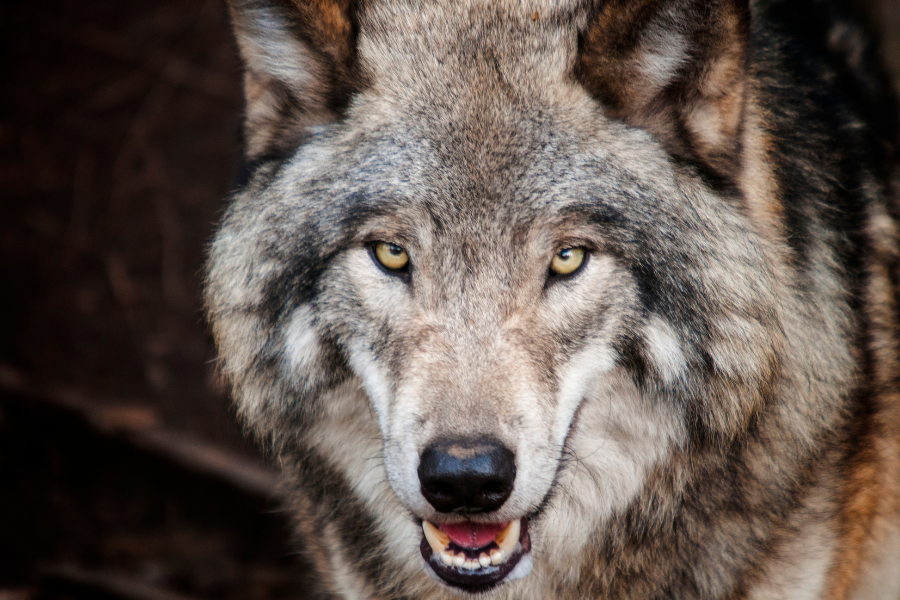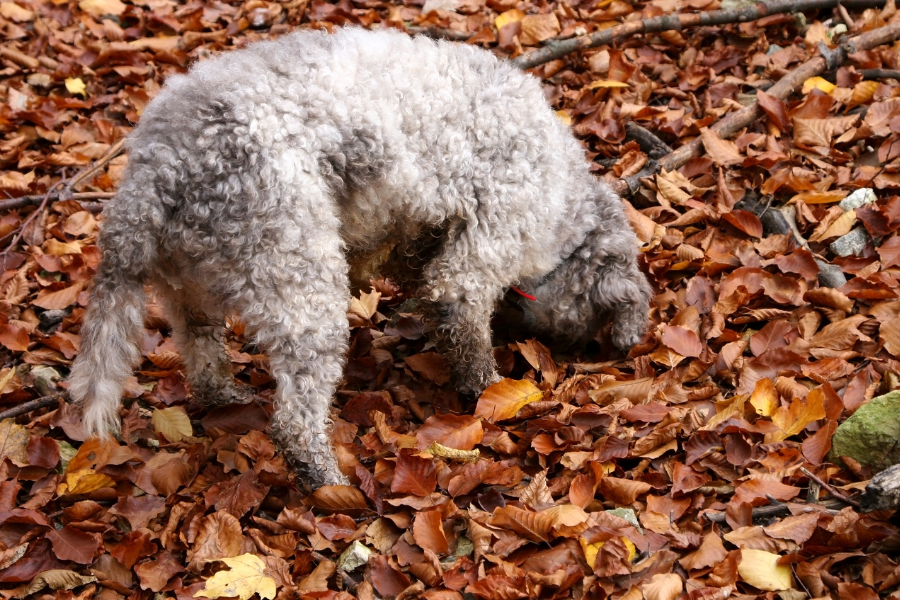So, we were watching the Animal Planet the other day and we were blown away when watching a pack of wolves play together. Their style of play was so strikingly similar to how dogs play, it inspired a deep dive into all things wolves and dogs – just how similar are dogs and wolves? And how clear are their ancestral connections? Today we are going to unlock these mysteries and share just how much of your dog’s genes and behavior are wolf-like!
The Ancestral Connection
Prepare to have your mind blown (unless you are an avid reader and already knew this piece of info), but did you know that every single dog breed out there, from a Cane Corso to a Yorkshire Terrier is related genetically to a wolf? Yep, it's true. Animal scientists agree that our cute, loveable dogs descended from gray wolves around 15,000 to 40,000 years ago, all thanks to some visionary cavemen!
The DNA similarities between wolves and dogs are mind-blowing – they share about 98.8% of their genetics! Just like brothers and sisters can turn out so different, dogs have evolved a lot from their ancestors over the thousands of years they've been with us.
Evolutionary Pressures
Different evolutionary pressures have led wolves and dogs down different paths. Wolves had to survive in the wild, relying on hunting and living in packs. Dogs, on the other hand, got comfy living with us, leading to big shifts in their behaviors and characters.
For example, wolves are top-level predators. They need to work together as a team to take down big game, while our dogs have evolved into sociable, trainable companions. These lifestyle changes are responsible for the differences we see in them today.
Understanding Genetic Adaptations
Interestingly, living with us has changed more than just their behavior. They have physical characteristics that set them apart from wolves, like differences in size, coat color, and even the shapes of their ears and tails. While wolves have strong bodies made for chasing down food, dogs have developed unique features that tie in with their roles in human society.
Wolf vs. Dog: The Social and Playful Scoop!
Let's talk about how wolves hang out together. They've got a pretty tight clique, ruled by the top dude and dudette. This squad system helps them team up for hunting and defending their turf. Dogs, though? They're way more chill! They see us as the bosses and are totally cool with it, making training a breeze.
Communication Jive
In the game of charades, wolves are pros! They use their voices, faces, and bodies to express themselves. Our canine pals, on the other hand, have had to become bilingual to fit in with us humans. They make similar noises, but also use a lot of body language and 'puppy dog eyes' to communicate. Understanding these signs can help you give your fur baby exactly what they're after.
Playtime!
Now, here's the fun part: Playtime! Both dogs and wolves love to play, but their styles couldn't be more different. Our pooches are super playful and have tons of ways to have fun. Wolves do play too, but it's more like practice for life skills, like hunting and teamwork.
Physical Differences
Physically, dogs and wolves may come from the same family, but they have clear differences. Wolves are generally larger and more muscular than most dogs. They need to be strong to hunt and defend their territory, while dogs have a range of body shapes that have been influenced by the roles they play in our lives.
Coat and Color Variations + Facial Features
Wolves tend to have thick double-layered fur that helps them survive in tough environments. Dogs, on the other hand, have an amazing variety of fur types, colors, and patterns. Each breed shows off unique features, from their faces to their coats. Plus, our canine buddies have evolved to show emotions through their faces, something we can easily connect with.
Training and Intelligence
In terms of intelligence, dogs and wolves have different ways of learning. Wolves are independent and use their instincts more than learned behaviours. Dogs, though, are awesome learners. They love positive reinforcement and are always eager to please us. This makes them highly trainable and great as service animals, therapy pets, or simply as our mates.
Both dogs and wolves are smart, but they show this in different ways. Wolves rely on their instincts and their pack to solve problems. Dogs, though, have been bred to excel at specific tasks, showing how they can be trained effectively.
One of the things that make dogs so lovable is their emotional intelligence. They can tell when we're down or excited and respond in a way that often makes us feel better. Wolves, while clever, don't share this emotional connection with humans. This is what makes the bond between us and our dogs so special.
Conclusion
Knowing these differences can really enhance your bond with your dog. It can help you choose the right breed if you're considering adopting, and make us all more responsible dog owners.
So, the next time you look at your dog, remember they have a rich history and unique traits that make them the best companions we could ask for. Want to learn more about curbing your pup? Try joining local dog training classes or look up educational resources about their behaviour. Because every dog deserves the best, and knowing their needs is the first step!
FAQ
Are Wolve More Powerful Than Dogs?
Who do you think would win in the strength category - wolves or dogs? If you're thinking about sheer muscle and survival skills, wolves have dogs beat. They're made for getting by in the wild, so they're super strong and made for hunting and dealing with rough landscapes. They've got muscles made for the long haul and quick sprints, which lets them chase some pretty big game like deer and elk. With really strong jaws and sharp teeth, wolves can bite harder than most dogs, which makes them pretty badass hunters.
Dogs, man, they're not just our best buds, they've got mad skills and neat gigs like herding sheep or guarding homes.
You've got those powerhouse pups like German Shepherds, Belgian Malinois, or Rottweilers, but even with their muscle, they'd lose in an arm wrestle with a wolf.
But who cares, right? Because where they lack in brute force, they totally make up for it in being super adaptable and downright gifted!
Like, check out the Border Collie, the boss of sheep herding, or the Labrador Retriever, a total MVP when it comes to fetch and swimming. They've got talents wolves would kill to have.
Sure, in the wild, wolves may be stronger, but when it comes to smarts, the ability to learn, and a massive range of skills, dogs are the real winners!
Wolves and dogs, both are insanely amazing and awe-inspiring in their own ways. Pretty rad, huh?
Can Wolves Be as Friendly as Dogs?
So, you're curious - can wolves be as buddy-buddy as dogs? Well, not so much. Sure, wolves and dogs come from the same family tree, but that's going back thousands of years. All that time and human involvement have made 'em different in many ways.
Wolves, being wild animals, naturally keep their guard up around humans and other animals that aren't part of their pack. It's all about survival for them. Even if you raise a wolf from when it was just a little pup, it won't show the same love and loyalty as a dog.
Of course, wolves can build some type of bond with humans. This is particularly true if the human has been there since the wolf was a cub. But, it's usually not as strong or reliable as the bond we share with dogs. Picture it this way: a wolf might put up with you, but a dog would go out of its way to hang out with you. It'll wag its tail, give you its paw, or snuggle up with you on the sofa. These differences are all in their DNA and have been developed through human selective breeding.
So, while wolves are cool creatures that we should preserve and understand, they aren't really cut out for the pet life. Dogs, however, have evolved right along with us, turning into the loving, loyal companions we're blessed to have.
References
1) Bergström A, Frantz L, Schmidt R, Ersmark E, Lebrasseur O, Girdland-Flink L, Lin AT, Storå J, Sjögren KG, Anthony D, Antipina E, Amiri S, Bar-Oz G, Bazaliiskii VI, Bulatović J, Brown D, Carmagnini A, Davy T, Fedorov S, Fiore I, Fulton D, Germonpré M, Haile J, Irving-Pease EK, Jamieson A, Janssens L, Kirillova I, Horwitz LK, Kuzmanovic-Cvetković J, Kuzmin Y, Losey RJ, Dizdar DL, Mashkour M, Novak M, Onar V, Orton D, Pasarić M, Radivojević M, Rajković D, Roberts B, Ryan H, Sablin M, Shidlovskiy F, Stojanović I, Tagliacozzo A, Trantalidou K, Ullén I, Villaluenga A, Wapnish P, Dobney K, Götherström A, Linderholm A, Dalén L, Pinhasi R, Larson G, Skoglund P. Origins and genetic legacy of prehistoric dogs. Science. 2020 Oct 30;370(6516):557-564. doi: 10.1126/science.aba9572. Epub 2020 Oct 29. PMID: 33122379; PMCID: PMC7116352.



